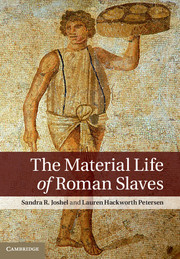Chapter 5 - Slaves in the Villa
Published online by Cambridge University Press: 05 November 2014
Summary
For a Roman city dweller, coastal Campania was a major attraction in the spring and summer. A visit to one’s villa overlooking the Bay of Naples provided the ideal setting for well-connected Romans to indulge in otium, or absolute leisure. . . . They could enjoy the views of the sea and the lush landscape, admire each other’s personal art collections, read and write, exercise in a private gymnasium, stroll in their gardens, and entertain friends.
—mattusch 2008, 1In certain regions, there are added to instrumentum (tools), if the villa is of the better equipped sort, such items as majordomos and sweepers, and if there are also gardens, gardeners . . . .
—Digest 33.7.8.1 (trans. a. watson)In 2008, the National Gallery of Art, Washington, DC, and the Los Angeles County Museum of Art organized an exhibition entitled Pompeii and the Roman Villa: Art and Culture around the Bay of Naples. The paintings, mosaics, statuary, tableware, jewelry, and decorative objects in the show well fulfilled the goal of its guest curator, Carol C. Mattusch, to give its viewers “a glimpse of the good life as it played out for Romans and their guests within the Campanian seaside villa and its surroundings” (2008, 1). As impressive as the exhibition was, at the same time, it nearly eliminated the bondsmen and bondswomen who made possible the “good life” in the villas around the Bay of Naples. The essays that front the catalog, for example, do not mention a single slave, although many of the activities mentioned required slave labor. This absence is frequent in much of the rich scholarship on the Roman villa except in the search for slave quarters, service areas, and agricultural apparatus. In this chapter, we look at the ways this silence reproduces the particular silences in ancient texts, and we try to meld literature, law, and archaeological evidence to relocate Roman slaves in the material realities of the Roman villa.
- Type
- Chapter
- Information
- The Material Life of Roman Slaves , pp. 162 - 213Publisher: Cambridge University PressPrint publication year: 2014



